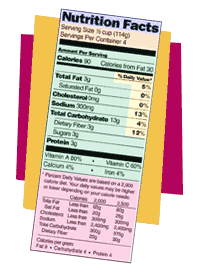Under regulations from the Food and Drug Administration of the Department of Health and Human Services and the Food Safety and Inspection Service of the U.S. Department of Agriculture, the food label offers more complete, useful and accurate nutrition information than ever before. With today's food labels, consumers get
- nutrition information about almost every food in the grocery store
- distinctive, easy-to-read formats that enable consumers to more quickly find the information they need to make healthful food choices
- information on the amount per serving of saturated fat, cholesterol, dietary fiber, and other nutrients of major health concern
- nutrient reference values, expressed as % Daily Values, that help consumers see how a food fits into an overall daily diet
- uniform definitions for terms that describe a food's nutrient content--such as "light," "low-fat," and "high-fiber"--to ensure that such terms mean the same for any product on which they appear
- claims about the relationship between a nutrient or food and a disease or health-related condition, such as calcium and osteoporosis, and fat and cancer. These are helpful for people who are concerned about eating foods that may help keep them healthier longer.
- standardized serving sizes that make nutritional comparisons of similar products easier
- declaration of total percentage of juice in juice drinks. This enables consumers to know exactly how much juice is in a product.
Begin with the Nutrition Facts panel, usually on the side or back of the package. The Nutrition Facts panel has two parts: The main or top section, which contains product-specific information (serving size, calories, and nutrient information) that varies with each food product; and the bottom part, which contains a footnote. This footnote is only on larger packages and provides general dietary information about important nutrients.
Several features of the Nutrition Panel help people with diabetes manage their diets. First of all, serving sizes now are more uniform among similar products and reflect the amounts people actually eat. The similarity makes it easier to compare the nutritional qualities of related foods. People who use the Exchange Lists should be aware that the serving size on the label may not be the same as that in the Exchange Lists. For example, the label serving size for orange juice is 8 fluid ounces (240 milliliters). In the exchange lists, the serving size is 4 ounces (one-half cup) or 120 mL. So, a person who drinks one cup of orange juice has used two fruit exchanges.
The label also gives grams of total carbohydrate, protein and fat, which can be used for carbohydrate counting. The values listed for total carbohydrates include all carbohydrates, including dietary fiber and sugars listed below it. Not singled out is complex carbohydrates, such as starches. The sugars include naturally present sugars, such as lactose in milk and fructose in fruits, and those added to the food, such as table sugar, corn syrup, and dextrose. The listing of grams of protein also is helpful for those restricting their protein intake, either to reduce their risk of kidney disease or to manage the kidney disease they have developed.
Elsewhere on the label, consumers may find claims about the food's nutritional benefits. These claims signal that the food contains desirable levels of certain nutrients. Some claims, such as "low fat," "no saturated fat," and "high fiber," describe nutrient levels. Some of these are particularly interesting to people with diabetes because they highlight foods containing nutrients at beneficial levels.
Other claims, called health claims, show a relationship between a nutrient or food and a disease or health condition. FDA has authorized a number of claims, which are based on significant scientific agreement. Three claims that relate to heart disease are of particular interest to people with diabetes:
- A diet low in saturated fat and cholesterol may help reduce the risk of coronary heart disease.
- A diet rich in fruits, vegetables and grain products that contain fiber, particularly soluble fiber, and are low in saturated fat and cholesterol may help reduce the risk of coronary heart disease.
- Soluble fiber from whole oats, as part of a diet low in saturated fat and cholesterol, may help reduce the risk of coronary heart disease.
Nutrient and health claims can be used only under certain circumstances, such as when the food contains appropriate levels of the stated nutrients.
0
FDA







